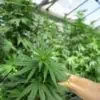TABLE OF CONTENTS
As June nears its end, some new to outdoor cultivation start to wonder what summer solstice means for cannabis growers. The summer solstice marks the longest day of the year. As photoperiodic plants, cannabis flowering depends on the light cycle. Understanding the light cycles and seasons of the year will help you plan a cultivation schedule that will maximize climate and light to produce a bountiful harvest!
What are Solstices and Equinoxes?
Understanding the basics of the earth’s orbit and axial tilt around the sun can help growers get a better sense of how the seasons and light cycles affect different stages of cannabis plant growth, from the planting stage to the harvest.
The Earth revolves around the sun in 365 days, 5 hours, 59 minutes, and 16 seconds. On four specific days each year (two solstices and two equinoxes), our planet’s seasons change. The solstices occur in June and December. The equinoxes take place in March and September.
Dates of each solstice and equinox change by a few days each year due to leap-year adjustments:
- Summer Solstice
- Northern Hemisphere: June 20 or 21
- Southern Hemisphere: December 21 or 22
- Autumnal Equinox
- Northern Hemisphere: September 22 or 23
- Southern Hemisphere: March 20 or 21
- Winter Solstice
- Northern Hemisphere: December 21 or 22
- Southern Hemisphere: June 20 or 21
- Vernal Equinox
- Northern Hemisphere: March 20 or 21
- Southern Hemisphere: September 22 or 23
Twice a year during the summer solstice, one of the Earth’s two poles has its maximum tilt toward the sun. These days mark the beginning of winter or summer, depending on the hemisphere and time of year. When the northern hemisphere is tilted closer to the sun, the southern hemisphere is tilted further away.
Flowering begins in light cycles with longer periods of darkness. Knowing when these changes occur outdoors helps growers plan to use the changes in daylight to their advantage. In an indoor setting, growers use artificial lights to simulate the changes in seasons.

Why Does the Summer Solstice Matter
The summer solstice marks the beginning of summer, bringing in long days, short nights, and warm weather. During the season’s optimal weather for cannabis growth, the plants put all of their energy into their vegetative growth (leaves and stems) before the daylight gets shorter and the flowering begins.
For cannabis growers, the summer solstice marks an important point in the plant’s life. By the summer solstice, outdoor growers must already have planted their seeds and developed young and healthy plants in the prime of their vegetative stage. If the plants were indoors and they plan to finish off outdoors, the plants should be out by the summer solstice.
For outdoor cannabis growers, the months around the summer solstice are the best for producing large and vigorous plants. During these months, the nights are short enough to stimulate vegetative growth, not flowering buds. Growers hoping to flower during this time can use blackout systems to increase the dark period and begin flowering early.
During this stage of growth, cannabis growers may perform training techniques such as topping to stimulate horizontal growth. Widening the plant’s canopy can create a more even distribution of sunlight to all of the leaves. In addition, plants will need more water as their roots grow bigger and a higher ratio of nitrogen to power their foliage growth.
Over the course of the season, the days will get shorter and the nights will get longer. Cannabis plants will keep growing their leaves and branches until the light-to-dark ratio begins to have longer periods of darkness.
Plants reveal their sex by summer’s end. If growing from clones or feminized seed, they'll be female plants. If growing from normal seed, the males will reveal their sex soon and should immediately be removed from the grow and destroyed because of the devastating effect they will have on the females you plan to harvest.
The autumnal equinox marks the day when the day and night are the same lengths. At this point, the light cycle will induce the flowering stage.
By the winter solstice, growers will have already harvested, dried, and cured their cannabis buds. After tending to their plants all season, they can finally take a break to create a wide range of infusions from the buds including cannabutter, tinctures, and topicals.
Learn to Grow Cannabis at Cannabis Training University
Are you ready to take your outdoor cannabis garden to the next level? Cannabis Training University can teach students of all skill levels the art of cannabis cultivation, all through a comprehensive online learning platform.
“
There are over 300,000 jobs in the cannabis industry. CTU trained me for one of them!

Makes $24.50 @ THC +
CTU’s cannabis cultivation course covers:
- Cannabis clones and seedlings
- Vegetative and flowering stages of cannabis
- Harvesting, curing, and trimming cannabis
- Cannabis garden troubleshooting
If you’re thinking of growing cannabis, CTU gives you a step-by-step growing guide all online, so you can learn how to grow weed from the comfort of your own home.

Luis Cordova
Luis Cordova is a distinguished author, and renowned expert in cannabis cultivation, who possesses a Master's degree in Plant Biotechnology and Pharmaceutical Science. As a valued contributor to highly esteemed publications such as Cannabis Training University and Maximum Yield Magazine, Luis has emerged as a trusted source of guidance and knowledge in the cannabis industry. Having written thousands of informative articles, Luis is widely recognized for his comprehensive expertise on cultivating cannabis, both indoors and outdoors.













 Jeff was involved in an accident where he endured a traumatic brain injury. He had a week-long stay in ICU where brain surgeons
Jeff was involved in an accident where he endured a traumatic brain injury. He had a week-long stay in ICU where brain surgeons  100% risk free money back guarantee within 48 hours after purchase if student has not completed any of the courses or exams.
100% risk free money back guarantee within 48 hours after purchase if student has not completed any of the courses or exams.